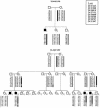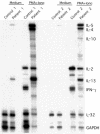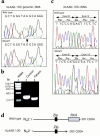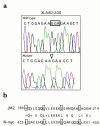JM2, encoding a fork head-related protein, is mutated in X-linked autoimmunity-allergic disregulation syndrome
- PMID: 11120765
- PMCID: PMC387260
- DOI: 10.1172/JCI11679
JM2, encoding a fork head-related protein, is mutated in X-linked autoimmunity-allergic disregulation syndrome
Abstract
X-linked autoimmunity-allergic disregulation syndrome (XLAAD) is an X-linked recessive immunological disorder characterized by multisystem autoimmunity, particularly early-onset type 1 diabetes mellitus, associated with manifestations of severe atopy including eczema, food allergy, and eosinophilic inflammation. Consistent with the allergic phenotype, analysis of two kindreds with XLAAD revealed marked skewing of patient T lymphocytes toward the Th2 phenotype. Using a positional-candidate approach, we have identified in both kindreds mutations in JM2, a gene on Xp11.23 that encodes a fork head domain-containing protein. One point mutation at a splice junction site results in transcripts that encode a truncated protein lacking the fork head homology domain. The other mutation involves an in-frame, 3-bp deletion that is predicted to impair the function of a leucine zipper dimerization domain. Our results point to a critical role for JM2 in self tolerance and Th cell differentiation.
Figures





Comment in
-
Escape from tolerance in the human X-linked autoimmunity-allergic disregulation syndrome and the Scurfy mouse.J Clin Invest. 2001 Jan;107(2):155-7. doi: 10.1172/JCI11966. J Clin Invest. 2001. PMID: 11160129 Free PMC article. No abstract available.
Similar articles
-
The dimerization domain of HNF-1alpha: structure and plasticity of an intertwined four-helix bundle with application to diabetes mellitus.J Mol Biol. 2001 Jul 13;310(3):635-58. doi: 10.1006/jmbi.2001.4780. J Mol Biol. 2001. PMID: 11439029
-
A recurrent RNA-splicing mutation in the SEDL gene causes X-linked spondyloepiphyseal dysplasia tarda.Am J Hum Genet. 2001 Jun;68(6):1398-407. doi: 10.1086/320594. Epub 2001 Apr 26. Am J Hum Genet. 2001. PMID: 11326333 Free PMC article.
-
The immune dysregulation, polyendocrinopathy, enteropathy, X-linked syndrome (IPEX) is caused by mutations of FOXP3.Nat Genet. 2001 Jan;27(1):20-1. doi: 10.1038/83713. Nat Genet. 2001. PMID: 11137993
-
Severe food allergy as a variant of IPEX syndrome caused by a deletion in a noncoding region of the FOXP3 gene.Gastroenterology. 2007 May;132(5):1705-17. doi: 10.1053/j.gastro.2007.02.044. Epub 2007 Feb 23. Gastroenterology. 2007. PMID: 17484868
-
Forkhead transcription factors: key players in development and metabolism.Dev Biol. 2002 Oct 1;250(1):1-23. doi: 10.1006/dbio.2002.0780. Dev Biol. 2002. PMID: 12297093 Review. No abstract available.
Cited by
-
Editorial: Immune metabolism in auto- and allo-immunity.Front Immunol. 2024 Sep 25;15:1483411. doi: 10.3389/fimmu.2024.1483411. eCollection 2024. Front Immunol. 2024. PMID: 39386213 Free PMC article. No abstract available.
-
Diverse Clinical and Immunological Profiles in Patients with IPEX Syndrome: a Multicenter Analysis from Turkey.J Clin Immunol. 2024 Sep 16;45(1):9. doi: 10.1007/s10875-024-01791-w. J Clin Immunol. 2024. PMID: 39283523
-
Inborn Errors of Immunity and Cytokine Storm Syndromes.Adv Exp Med Biol. 2024;1448:185-207. doi: 10.1007/978-3-031-59815-9_14. Adv Exp Med Biol. 2024. PMID: 39117816 Review.
-
Oral tolerance to dietary antigens and Foxp3+ regulatory T cells.Immunol Rev. 2024 Sep;326(1):8-16. doi: 10.1111/imr.13370. Epub 2024 Jul 25. Immunol Rev. 2024. PMID: 39054615 Review.
-
Association between FOXP3 polymorphisms and expression and neuromyelitis optica spectrum disorder risk in the Northern Chinese Han population.Transl Neurosci. 2024 Apr 5;15(1):20220337. doi: 10.1515/tnsci-2022-0337. eCollection 2024 Jan 1. Transl Neurosci. 2024. PMID: 38584670 Free PMC article.
References
-
- Powell BR, Buist NR, Stenzel P. An X-linked syndrome of diarrhea, polyendocrinopathy, and fatal infection in infancy. J Pediatr. 1982;100:731–737. - PubMed
-
- Satake N, et al. A Japanese family of X-linked auto-immune enteropathy with haemolytic anaemia and polyendocrinopathy. Eur J Pediatr. 1993;152:313–315. - PubMed
-
- Roberts J, Searle J. Neonatal diabetes mellitus associated with severe diarrhea, hyperimmunoglobulin E syndrome, and absence of islets of Langerhans. Pediatr Pathol Lab Med. 1995;15:477–483. - PubMed
Publication types
MeSH terms
Substances
Grants and funding
LinkOut - more resources
Full Text Sources
Other Literature Sources
Medical
Molecular Biology Databases

